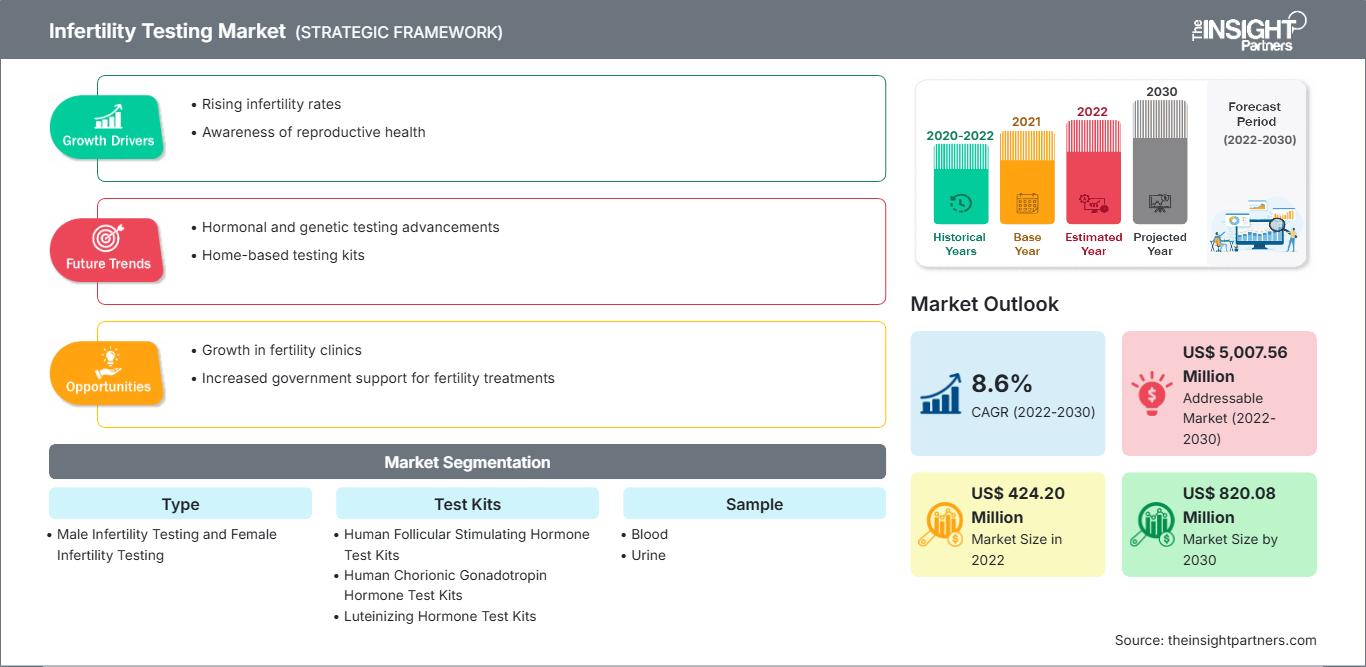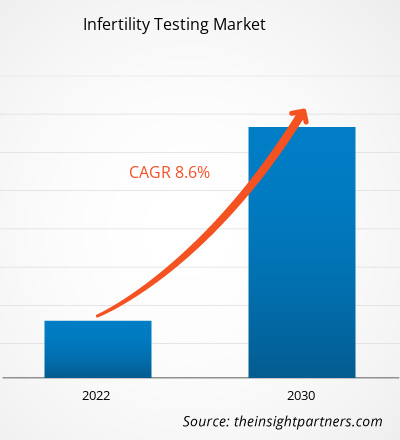[研究报告] 不孕不育检测市场规模预计将从2022年的4.242亿美元增长到2030年的8.2008亿美元;预计该市场在2022年至2030年期间的复合年增长率将达到8.6%。
市场洞察与分析师观点:
男性和女性不孕不育病例的增加以及不孕不育检测技术的不断进步等因素推动了市场的增长。然而,人们对不孕不育检测试剂盒缺乏认识以及其局限性阻碍了市场的增长。
在生殖能力方面,不孕不育是指既不影响个人身体机能也不会危及生命的缺陷。然而,它可能会影响个人(包括男性和女性)的发展,削弱他们的个性并导致挫败感。约有5000万至8000万对夫妇在其生育生涯中至少经历过一次不孕不育问题。发展中国家与发达国家的不孕不育状况有所不同。世界卫生组织 (WHO) 的数据显示,六分之一的夫妇患有不孕不育症。随着人们检测意识的提高和生活方式的改变,以及不健康饮食导致男性和女性不孕不育和妇科疾病的趋势日益明显,不孕不育检测市场规模不断扩大。此外,排卵监测技术的进步也推动了市场的增长。吸烟和烟草消费的增加将导致不孕不育病例增加,从而刺激对不孕不育检测的需求。此外,人们生育意识的增强、受多囊卵巢综合征 (PCOS) 影响的女性人口不断增长、男性和女性对自我检测和远程监控检测的需求不断增长以及新产品的创新,预计将在预测期内为不孕不育检测市场创造机会。
增长动力:
男性和女性不孕不育病例的增加推动不孕不育检测市场的增长
男性不育是一个全球普遍存在的问题,不同地区的百分比各不相同。根据世界卫生组织的数据,约 20% 的不孕不育夫妇的问题在于男性伴侣,而 30% 的夫妇的不孕不育问题在于双方。导致男性不育的常见因素包括脑垂体激素水平低、精液缺乏和精液质量差、影响精液进入阴道的性问题以及存在精子抗体。导致精子数量低的最常见原因是精索静脉曲张,即睾丸静脉扩张。根据美国卫生与公众服务部的数据,约40%患有不育症的男性患有精索静脉曲张。精子数量低导致男性不育,从而刺激了不育症检测市场的发展。
由于晚婚和年龄相关性不育症增加等多种因素,全球生育率正在稳步下降。据世界卫生组织估计,2020年全球成年人(15-49岁)新增衣原体感染病例约1.285亿。15-49岁人群中衣原体感染的患病率估计为女性4.0%,男性2.5%。根据美国疾病控制与预防中心 (CDC) 的数据,在美国,约有 10%(610 万)15 至 44 岁的女性在怀孕或维持妊娠方面存在困难。因此,生育率的下降推动了对不孕不育检测的需求,以确定男性和女性不孕不育的原因,从而推动了不孕不育检测市场的增长。
自定义此报告以满足您的要求
您将免费获得任何报告的定制,包括本报告的部分内容,或国家级分析、Excel 数据包,以及为初创企业和大学提供超值优惠和折扣
不孕不育检测市场: 战略洞察

-
获取本报告的主要市场趋势。这个免费样本将包括数据分析,从市场趋势到估计和预测。
报告细分和范围:
“不孕不育检测市场分析”通过考虑以下细分市场进行:类型、检测试剂盒、样本和最终用户。
细分分析:
不孕不育检测市场按类型分为男性不孕不育检测和女性不孕不育检测。女性不孕不育检测在2022年占据了更大的市场份额。预计男性不孕不育检测在预测期内的复合年增长率将达到9.2%。压力水平的增加、肥胖、吸烟和饮酒都是导致男性不育的因素。此外,人们对不孕不育认识的不断提高、研发支出的增加、主要不孕不育检测市场参与者推出产品的举措以及生活方式的改变,都推动了男性不孕不育检测领域的市场增长。
根据检测试剂盒,不孕不育检测市场可细分为人类促卵泡激素 (FSH) 检测试剂盒、人绒毛膜促性腺激素 (HCG) 检测试剂盒、黄体生成素 (LH) 检测试剂盒等。人类促卵泡激素 (FSH) 检测试剂盒细分市场在 2022 年占据最大市场份额,预计在预测期内将录得 9.2% 的最高复合年增长率。促卵泡激素 (FSH) 检测试剂盒有助于测量血液中 FSH 激素的浓度。该测试通常用于评估男性和女性的 FSH 水平,以诊断生育问题、更年期或性发育问题等各种原因。 FSH 有助于控制女性的月经周期和卵巢中含有卵子的卵泡的生长。对于男性,FSH 调节精子的生成和运输。该测试用于确定精子数量。因此,FSH 检测试剂盒是评估生殖问题和其他与激素失衡相关疾病的重要诊断工具。此外,先进的生物仿制药 FSH 产品、监管部门的批准、市场准入、FSH 试剂盒生产技术的进步以及对有效避孕方法日益增长的需求预计将加速全球市场的增长。
按样本划分,不孕不育检测市场可分为血液、尿液和其他样本。血液样本在 2022 年占据了最大的市场份额。预计在预测期内,血液样本的复合年增长率将达到 9.1%。不孕不育检测通常通过血液检测来测量重要的激素。根据夫妻双方的情况,女性和男性可能需要进行不同的血液检测。可能需要进行的血液检测包括促卵泡激素 (FSH)、抗苗勒氏管激素 (AMH)、促黄体生成素 (LH) 等。2021 年 1 月,健康初创公司 Yesmom 推出了亚洲首款家用女性生育力血液检测试剂盒,帮助女性在家中舒适地关注生殖健康。
按最终用户划分,不孕不育检测市场分为医院和诊所、生育中心和家庭护理。家庭护理细分市场在 2022 年占据最大市场份额,预计在预测期内将录得 9.0% 的最高复合年增长率。由于患者倾向于自我监测健康状况、电商网站上生育力检测试剂盒的便捷获取、用户友好且易于使用的设备日益普及,以及对检测结果保密性的日益重视,预计该细分市场将持续增长。
辅助生殖技术 (ART) 和体外受精 (IVF) 的普及将加速不孕不育检测市场的发展
随着人们对不孕不育问题的认识不断提高,预计将在未来几年刺激对 IVF 和 ART 治疗的需求。在预测期内,先进的卵胞浆内单精子注射疗法的引入以及对 IVF 治疗药物和外科手术的认识不断提高,预计将推动不孕不育检测市场的发展。根据加州大学旧金山分校医疗中心的数据,约 10% 的不孕不育问题源于不明原因,另外 30% 则源于男性和女性伴侣的问题。
男性常见的手术包括卵胞浆内单精子注射 (ICSI)、附睾穿刺、附睾穿刺、睾丸精子提取以及失败测试的映射。约 75% 的男性因素会导致可识别或可治疗的生育问题。此外,几乎所有男性因素导致的不孕不育都可以通过 ART 治疗。因此,ART 和 IVF 的日益普及可能会在未来几年带来新的不孕不育检测市场趋势。
区域分析:
不孕不育检测市场报告的范围包括北美、欧洲、亚太地区、南美和中美以及中东和非洲。
2022 年,北美占据了不孕不育检测市场的最大份额。该地区市场的增长动力源于不孕不育发病率高、男性和女性不孕不育检测意识增强、女性初次怀孕年龄上升以及通过电商网站轻松获取不孕不育检测试剂盒。此外,吸烟和烟草消费的日益普及将导致不孕不育病例增加,从而推动市场增长。检测意识的增强以及受多囊卵巢综合征 (PCOS) 影响的女性人口不断增长也加速了市场的增长。
欧洲不孕不育检测市场预计将占据全球第三大市场份额。欧洲市场的增长动力源于人们对不孕不育问题认识的不断提高、糖尿病患者人数的增加、该地区大量参与者的存在以及政府在生育方面的举措。根据欧洲人类生殖与胚胎学会 (ESHES) 的数据,2021 年欧洲将有超过 2500 万人受不孕不育影响。在欧洲,每个小学班级都会有一名婴儿通过辅助生殖技术 (ART) 出生;在北欧国家,2% 至 7% 的新生儿来自辅助生殖技术 (ART)。西班牙是治疗不孕不育的首选目的地国之一,因为与其他欧盟国家相比,西班牙拥有更完善的法律框架、高水平的不孕不育专业人员、一流的医疗设施和先进的医疗技术。欧洲生育协会 (FE) 是欧洲 20 多个国家中致力于不孕不育问题的协会的伞状组织。该组织旨在改善不孕不育患者的权利,在欧洲患者中建立强大的跨境网络,以取得并分享最佳实践,提高社会对不孕不育的认识,并促进生殖健康保护领域的教育。
预计亚太地区的不孕不育检测市场在预测期内将以 9.1% 的最快增长率增长。区域市场的增长归因于受生活方式障碍影响的女性数量的增加、不孕不育检测产品开发资金/投资的增加,以及国际和国内参与者对亚太不孕不育检测市场的关注度增加。
不孕不育检测
不孕不育检测市场区域洞察The Insight Partners 的分析师已详尽阐述了预测期内影响不孕不育检测市场的区域趋势和因素。本节还探讨了北美、欧洲、亚太地区、中东和非洲以及南美和中美洲的不孕不育检测市场细分和地域分布。
不孕不育检测市场报告范围
| 报告属性 | 细节 |
|---|---|
| 市场规模 2022 | US$ 424.20 Million |
| 市场规模 2030 | US$ 820.08 Million |
| 全球复合年增长率 (2022 - 2030) | 8.6% |
| 历史数据 | 2020-2022 |
| 预测期 | 2022-2030 |
| 涵盖的领域 |
By 类型
|
| 覆盖地区和国家 |
北美
|
| 市场领导者和主要公司简介 |
|
不孕不育检测市场参与者密度:了解其对业务动态的影响
不孕不育检测市场正在快速增长,这得益于终端用户需求的不断增长,而这些需求的驱动因素包括消费者偏好的演变、技术进步以及对产品优势的认知度的提升。随着需求的增长,企业正在扩展其产品线,不断创新以满足消费者需求,并抓住新兴趋势,从而进一步推动市场增长。

- 获取 不孕不育检测市场 主要参与者概述
行业发展和未来机遇:
不孕不育检测市场预测可以帮助该市场的利益相关者规划其增长战略。根据市场领先企业的新闻稿,以下列出了一些战略发展:
- 2023 年 7 月,备受尊敬的自我诊断检测全球领导者 2San 与 Proov 合作,在美国中西部八个州的精选 Hy-Vee 门店推出了其独家、易于使用的家用生育测试。
- 2022 年 1 月,领先的生育和家庭建设护理提供商 Kindbody 推出了其消费产品部门 Kind at Home,致力于在整个生殖过程中为人们提供支持。该计划始于推出用户友好的男性和女性家用生育激素检测产品。
- 2021年12月,Carrot Fertility宣布推出一款全新试剂盒,帮助人们在家中监测生育激素和相关生物标志物。定制化的检测试剂盒可以更全面地了解生育健康状况,使人们能够在家中舒适地尽早采取行动和干预。
竞争格局和主要公司:
默克集团 (MerckKgaA)、宝洁 (Procter & Gamble)、bioMerieux SA、Alere Inc.、Babystart Ltd.、bioZhena Corporation、Quidel Corporation、CENTOGENE NV、SCSA Diagnostics, Inc. 和 Boditech Med Inc. 都是不孕不育检测市场报告中介绍的知名公司。这些公司专注于开发新技术、升级现有产品并扩大其地域覆盖范围,以满足全球日益增长的消费者需求。
- 历史分析(2 年)、基准年、预测(7 年)及复合年增长率
- PEST和SWOT分析
- 市场规模、价值/数量 - 全球、区域、国家
- 行业和竞争格局
- Excel 数据集
近期报告
相关报告
客户评价
购买理由
- 明智的决策
- 了解市场动态
- 竞争分析
- 客户洞察
- 市场预测
- 风险规避
- 战略规划
- 投资论证
- 识别新兴市场
- 优化营销策略
- 提升运营效率
- 顺应监管趋势






















 获取免费样品 - 不孕不育检测市场
获取免费样品 - 不孕不育检测市场